Knowledge Management and Analytics Report
VerifiedAdded on 2020/02/24
|18
|3913
|462
Report
AI Summary
This report analyzes the use of Moodle as a knowledge management tool in higher education. It discusses its features, benefits, and the role of big data in enhancing learning outcomes. The report includes a literature review, critical analysis, and a discussion on collaborative learning, highlighting how Moodle facilitates knowledge creation, sharing, and management among students and educators.
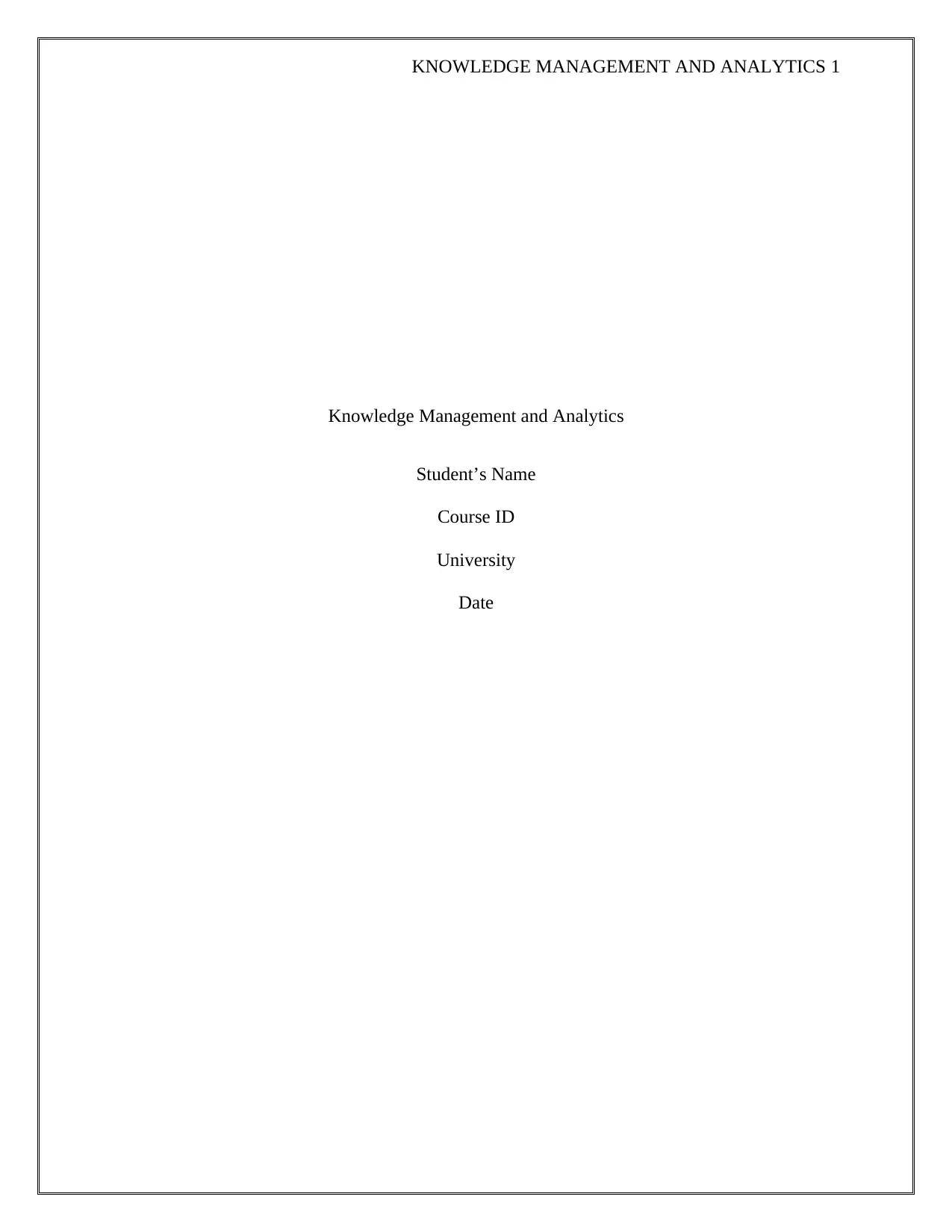
KNOWLEDGE MANAGEMENT AND ANALYTICS 1
Knowledge Management and Analytics
Student’s Name
Course ID
University
Date
Knowledge Management and Analytics
Student’s Name
Course ID
University
Date
Paraphrase This Document
Need a fresh take? Get an instant paraphrase of this document with our AI Paraphraser
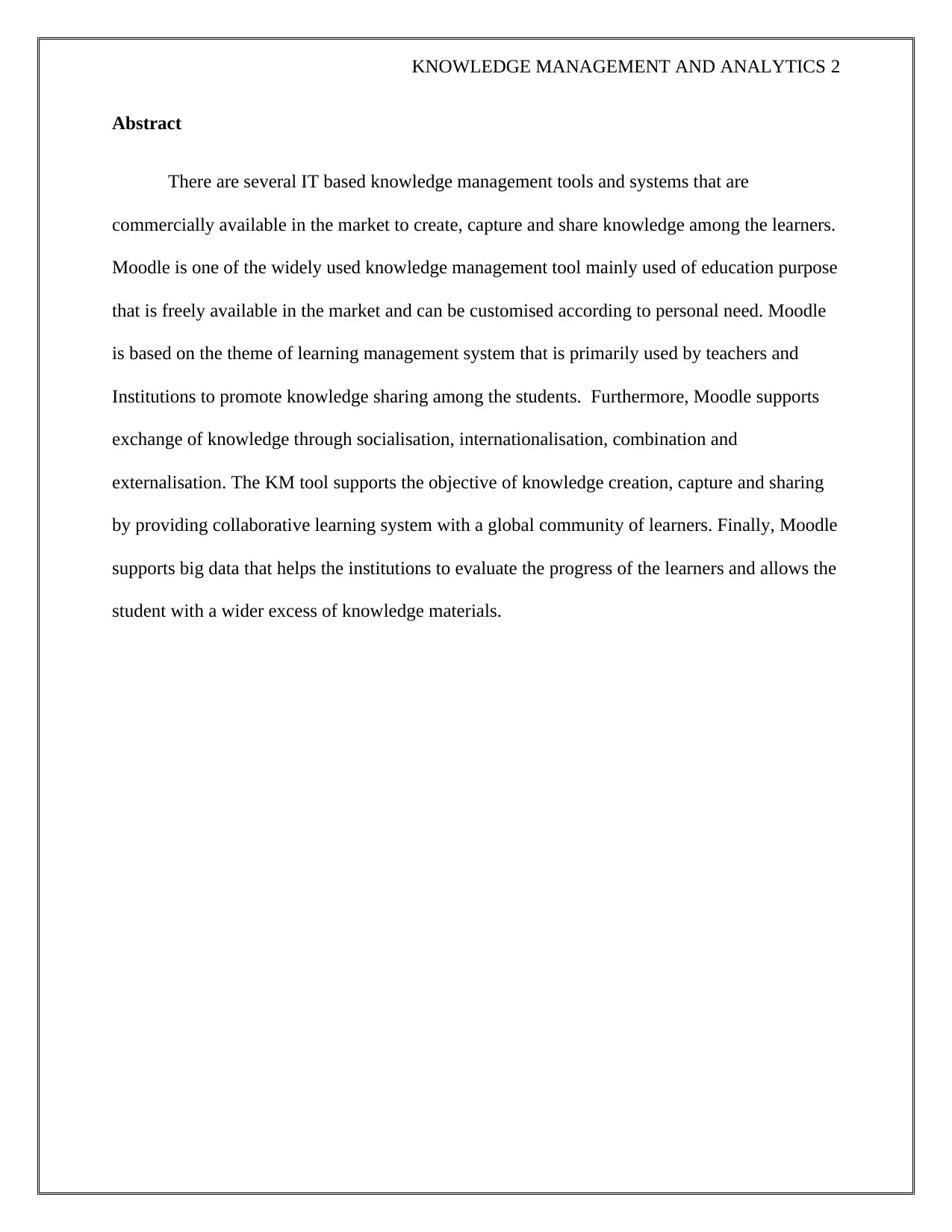
KNOWLEDGE MANAGEMENT AND ANALYTICS 2
Abstract
There are several IT based knowledge management tools and systems that are
commercially available in the market to create, capture and share knowledge among the learners.
Moodle is one of the widely used knowledge management tool mainly used of education purpose
that is freely available in the market and can be customised according to personal need. Moodle
is based on the theme of learning management system that is primarily used by teachers and
Institutions to promote knowledge sharing among the students. Furthermore, Moodle supports
exchange of knowledge through socialisation, internationalisation, combination and
externalisation. The KM tool supports the objective of knowledge creation, capture and sharing
by providing collaborative learning system with a global community of learners. Finally, Moodle
supports big data that helps the institutions to evaluate the progress of the learners and allows the
student with a wider excess of knowledge materials.
Abstract
There are several IT based knowledge management tools and systems that are
commercially available in the market to create, capture and share knowledge among the learners.
Moodle is one of the widely used knowledge management tool mainly used of education purpose
that is freely available in the market and can be customised according to personal need. Moodle
is based on the theme of learning management system that is primarily used by teachers and
Institutions to promote knowledge sharing among the students. Furthermore, Moodle supports
exchange of knowledge through socialisation, internationalisation, combination and
externalisation. The KM tool supports the objective of knowledge creation, capture and sharing
by providing collaborative learning system with a global community of learners. Finally, Moodle
supports big data that helps the institutions to evaluate the progress of the learners and allows the
student with a wider excess of knowledge materials.
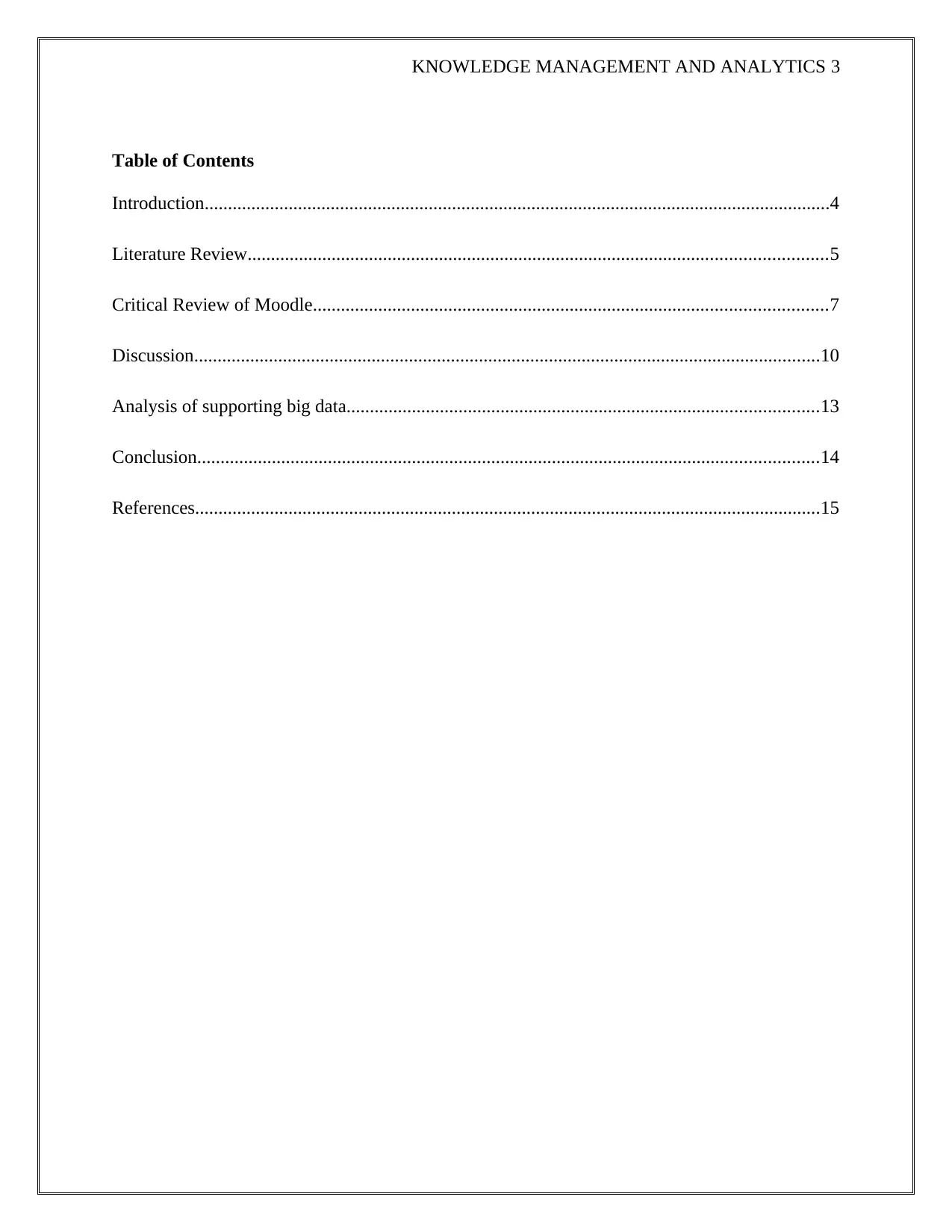
KNOWLEDGE MANAGEMENT AND ANALYTICS 3
Table of Contents
Introduction......................................................................................................................................4
Literature Review............................................................................................................................5
Critical Review of Moodle..............................................................................................................7
Discussion......................................................................................................................................10
Analysis of supporting big data.....................................................................................................13
Conclusion.....................................................................................................................................14
References......................................................................................................................................15
Table of Contents
Introduction......................................................................................................................................4
Literature Review............................................................................................................................5
Critical Review of Moodle..............................................................................................................7
Discussion......................................................................................................................................10
Analysis of supporting big data.....................................................................................................13
Conclusion.....................................................................................................................................14
References......................................................................................................................................15
⊘ This is a preview!⊘
Do you want full access?
Subscribe today to unlock all pages.

Trusted by 1+ million students worldwide
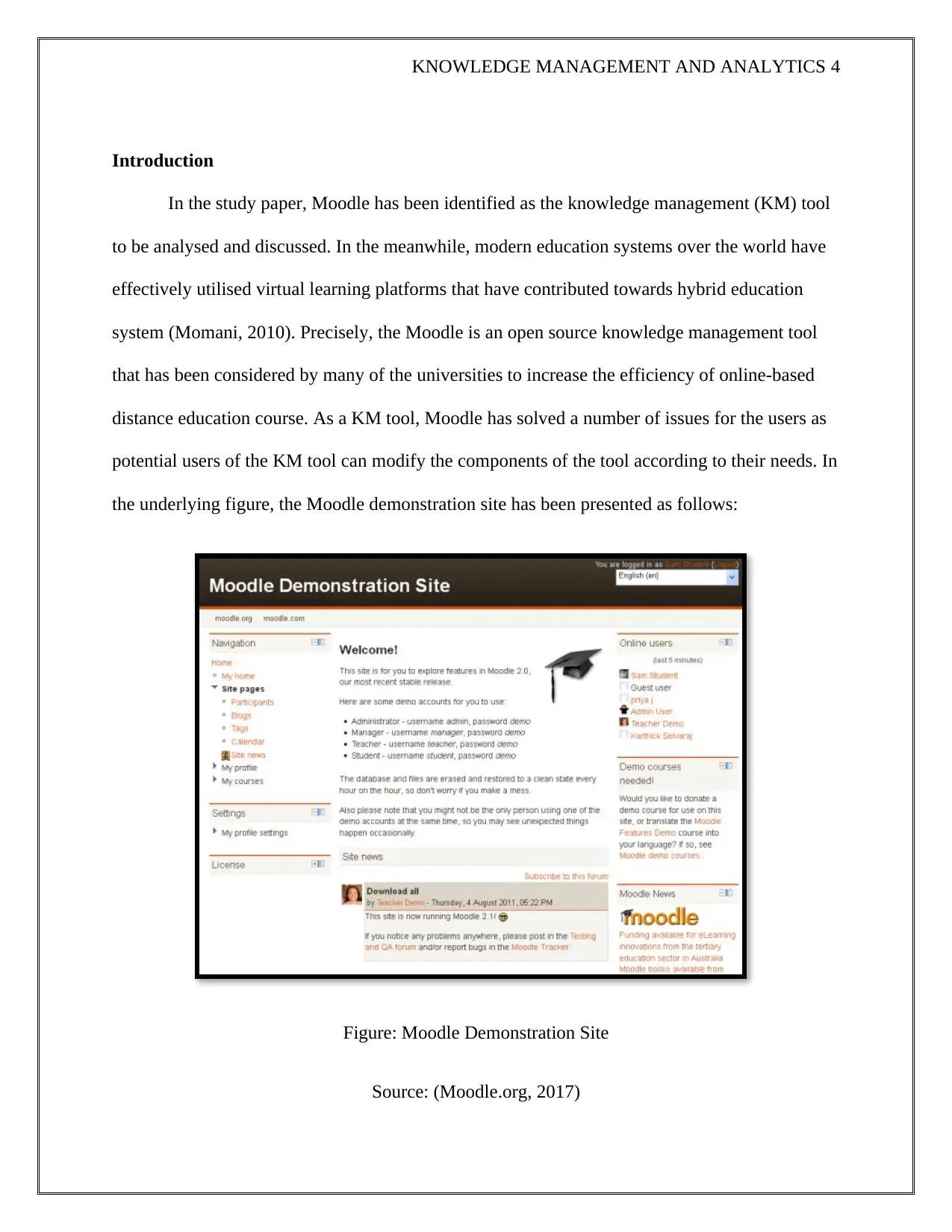
KNOWLEDGE MANAGEMENT AND ANALYTICS 4
Introduction
In the study paper, Moodle has been identified as the knowledge management (KM) tool
to be analysed and discussed. In the meanwhile, modern education systems over the world have
effectively utilised virtual learning platforms that have contributed towards hybrid education
system (Momani, 2010). Precisely, the Moodle is an open source knowledge management tool
that has been considered by many of the universities to increase the efficiency of online-based
distance education course. As a KM tool, Moodle has solved a number of issues for the users as
potential users of the KM tool can modify the components of the tool according to their needs. In
the underlying figure, the Moodle demonstration site has been presented as follows:
Figure: Moodle Demonstration Site
Source: (Moodle.org, 2017)
Introduction
In the study paper, Moodle has been identified as the knowledge management (KM) tool
to be analysed and discussed. In the meanwhile, modern education systems over the world have
effectively utilised virtual learning platforms that have contributed towards hybrid education
system (Momani, 2010). Precisely, the Moodle is an open source knowledge management tool
that has been considered by many of the universities to increase the efficiency of online-based
distance education course. As a KM tool, Moodle has solved a number of issues for the users as
potential users of the KM tool can modify the components of the tool according to their needs. In
the underlying figure, the Moodle demonstration site has been presented as follows:
Figure: Moodle Demonstration Site
Source: (Moodle.org, 2017)
Paraphrase This Document
Need a fresh take? Get an instant paraphrase of this document with our AI Paraphraser
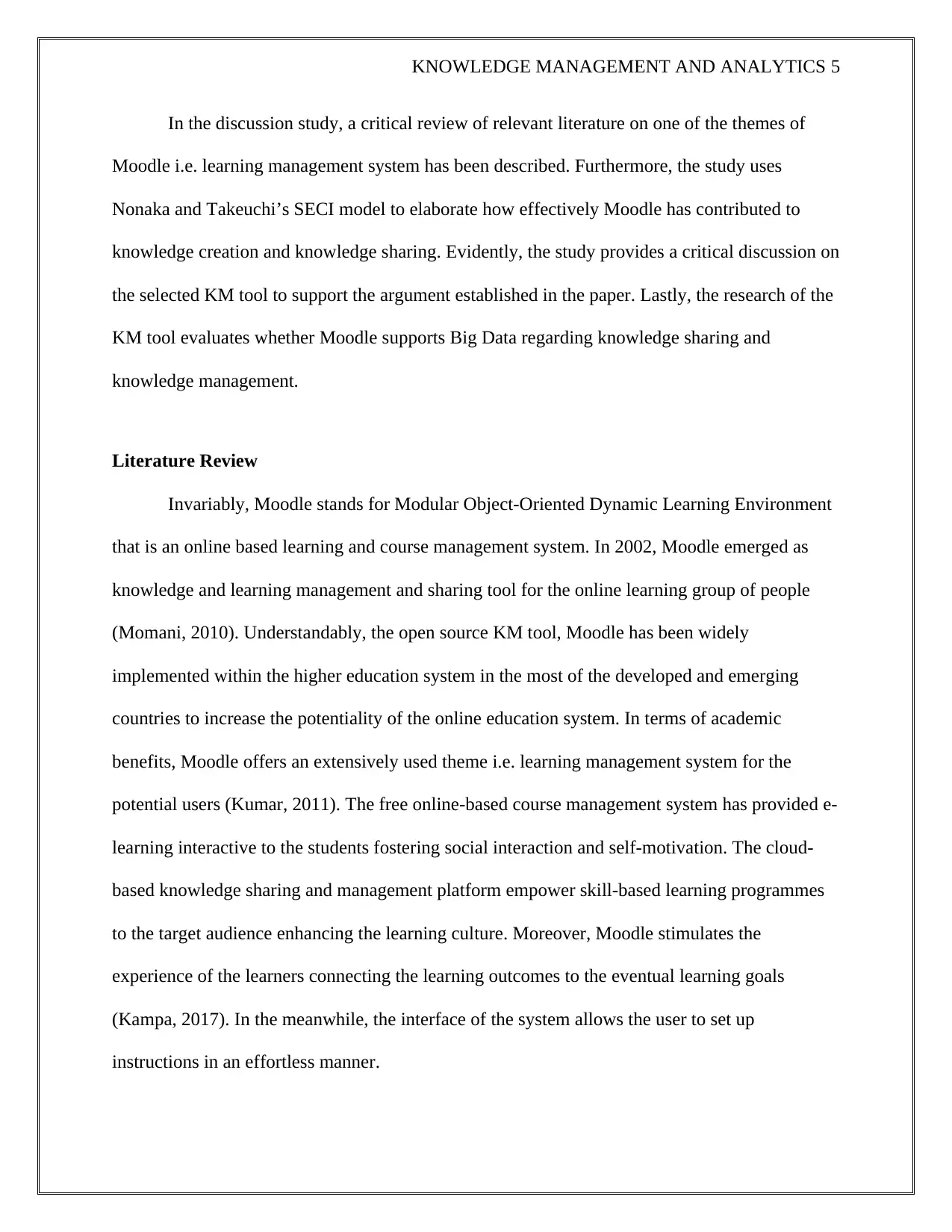
KNOWLEDGE MANAGEMENT AND ANALYTICS 5
In the discussion study, a critical review of relevant literature on one of the themes of
Moodle i.e. learning management system has been described. Furthermore, the study uses
Nonaka and Takeuchi’s SECI model to elaborate how effectively Moodle has contributed to
knowledge creation and knowledge sharing. Evidently, the study provides a critical discussion on
the selected KM tool to support the argument established in the paper. Lastly, the research of the
KM tool evaluates whether Moodle supports Big Data regarding knowledge sharing and
knowledge management.
Literature Review
Invariably, Moodle stands for Modular Object-Oriented Dynamic Learning Environment
that is an online based learning and course management system. In 2002, Moodle emerged as
knowledge and learning management and sharing tool for the online learning group of people
(Momani, 2010). Understandably, the open source KM tool, Moodle has been widely
implemented within the higher education system in the most of the developed and emerging
countries to increase the potentiality of the online education system. In terms of academic
benefits, Moodle offers an extensively used theme i.e. learning management system for the
potential users (Kumar, 2011). The free online-based course management system has provided e-
learning interactive to the students fostering social interaction and self-motivation. The cloud-
based knowledge sharing and management platform empower skill-based learning programmes
to the target audience enhancing the learning culture. Moreover, Moodle stimulates the
experience of the learners connecting the learning outcomes to the eventual learning goals
(Kampa, 2017). In the meanwhile, the interface of the system allows the user to set up
instructions in an effortless manner.
In the discussion study, a critical review of relevant literature on one of the themes of
Moodle i.e. learning management system has been described. Furthermore, the study uses
Nonaka and Takeuchi’s SECI model to elaborate how effectively Moodle has contributed to
knowledge creation and knowledge sharing. Evidently, the study provides a critical discussion on
the selected KM tool to support the argument established in the paper. Lastly, the research of the
KM tool evaluates whether Moodle supports Big Data regarding knowledge sharing and
knowledge management.
Literature Review
Invariably, Moodle stands for Modular Object-Oriented Dynamic Learning Environment
that is an online based learning and course management system. In 2002, Moodle emerged as
knowledge and learning management and sharing tool for the online learning group of people
(Momani, 2010). Understandably, the open source KM tool, Moodle has been widely
implemented within the higher education system in the most of the developed and emerging
countries to increase the potentiality of the online education system. In terms of academic
benefits, Moodle offers an extensively used theme i.e. learning management system for the
potential users (Kumar, 2011). The free online-based course management system has provided e-
learning interactive to the students fostering social interaction and self-motivation. The cloud-
based knowledge sharing and management platform empower skill-based learning programmes
to the target audience enhancing the learning culture. Moreover, Moodle stimulates the
experience of the learners connecting the learning outcomes to the eventual learning goals
(Kampa, 2017). In the meanwhile, the interface of the system allows the user to set up
instructions in an effortless manner.
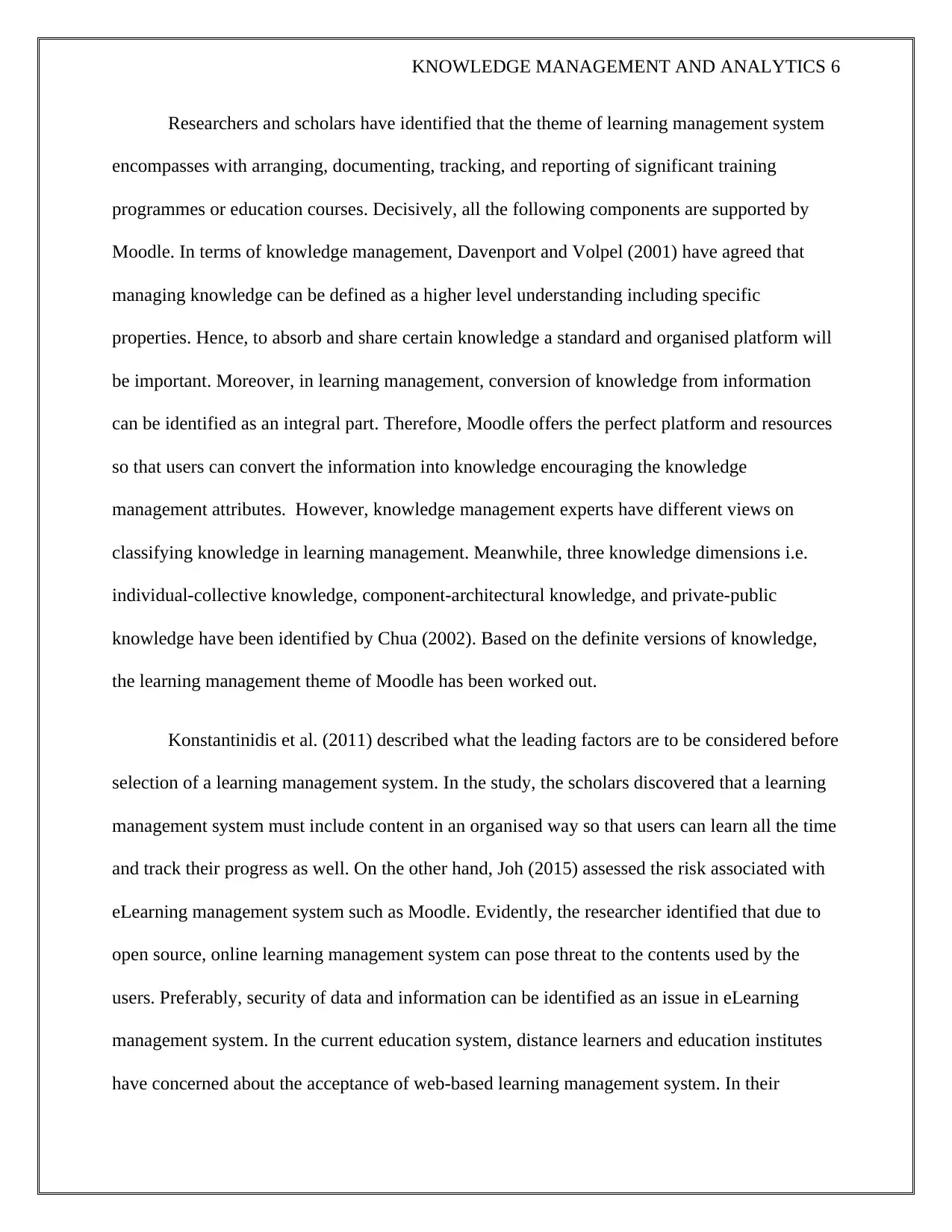
KNOWLEDGE MANAGEMENT AND ANALYTICS 6
Researchers and scholars have identified that the theme of learning management system
encompasses with arranging, documenting, tracking, and reporting of significant training
programmes or education courses. Decisively, all the following components are supported by
Moodle. In terms of knowledge management, Davenport and Volpel (2001) have agreed that
managing knowledge can be defined as a higher level understanding including specific
properties. Hence, to absorb and share certain knowledge a standard and organised platform will
be important. Moreover, in learning management, conversion of knowledge from information
can be identified as an integral part. Therefore, Moodle offers the perfect platform and resources
so that users can convert the information into knowledge encouraging the knowledge
management attributes. However, knowledge management experts have different views on
classifying knowledge in learning management. Meanwhile, three knowledge dimensions i.e.
individual-collective knowledge, component-architectural knowledge, and private-public
knowledge have been identified by Chua (2002). Based on the definite versions of knowledge,
the learning management theme of Moodle has been worked out.
Konstantinidis et al. (2011) described what the leading factors are to be considered before
selection of a learning management system. In the study, the scholars discovered that a learning
management system must include content in an organised way so that users can learn all the time
and track their progress as well. On the other hand, Joh (2015) assessed the risk associated with
eLearning management system such as Moodle. Evidently, the researcher identified that due to
open source, online learning management system can pose threat to the contents used by the
users. Preferably, security of data and information can be identified as an issue in eLearning
management system. In the current education system, distance learners and education institutes
have concerned about the acceptance of web-based learning management system. In their
Researchers and scholars have identified that the theme of learning management system
encompasses with arranging, documenting, tracking, and reporting of significant training
programmes or education courses. Decisively, all the following components are supported by
Moodle. In terms of knowledge management, Davenport and Volpel (2001) have agreed that
managing knowledge can be defined as a higher level understanding including specific
properties. Hence, to absorb and share certain knowledge a standard and organised platform will
be important. Moreover, in learning management, conversion of knowledge from information
can be identified as an integral part. Therefore, Moodle offers the perfect platform and resources
so that users can convert the information into knowledge encouraging the knowledge
management attributes. However, knowledge management experts have different views on
classifying knowledge in learning management. Meanwhile, three knowledge dimensions i.e.
individual-collective knowledge, component-architectural knowledge, and private-public
knowledge have been identified by Chua (2002). Based on the definite versions of knowledge,
the learning management theme of Moodle has been worked out.
Konstantinidis et al. (2011) described what the leading factors are to be considered before
selection of a learning management system. In the study, the scholars discovered that a learning
management system must include content in an organised way so that users can learn all the time
and track their progress as well. On the other hand, Joh (2015) assessed the risk associated with
eLearning management system such as Moodle. Evidently, the researcher identified that due to
open source, online learning management system can pose threat to the contents used by the
users. Preferably, security of data and information can be identified as an issue in eLearning
management system. In the current education system, distance learners and education institutes
have concerned about the acceptance of web-based learning management system. In their
⊘ This is a preview!⊘
Do you want full access?
Subscribe today to unlock all pages.

Trusted by 1+ million students worldwide
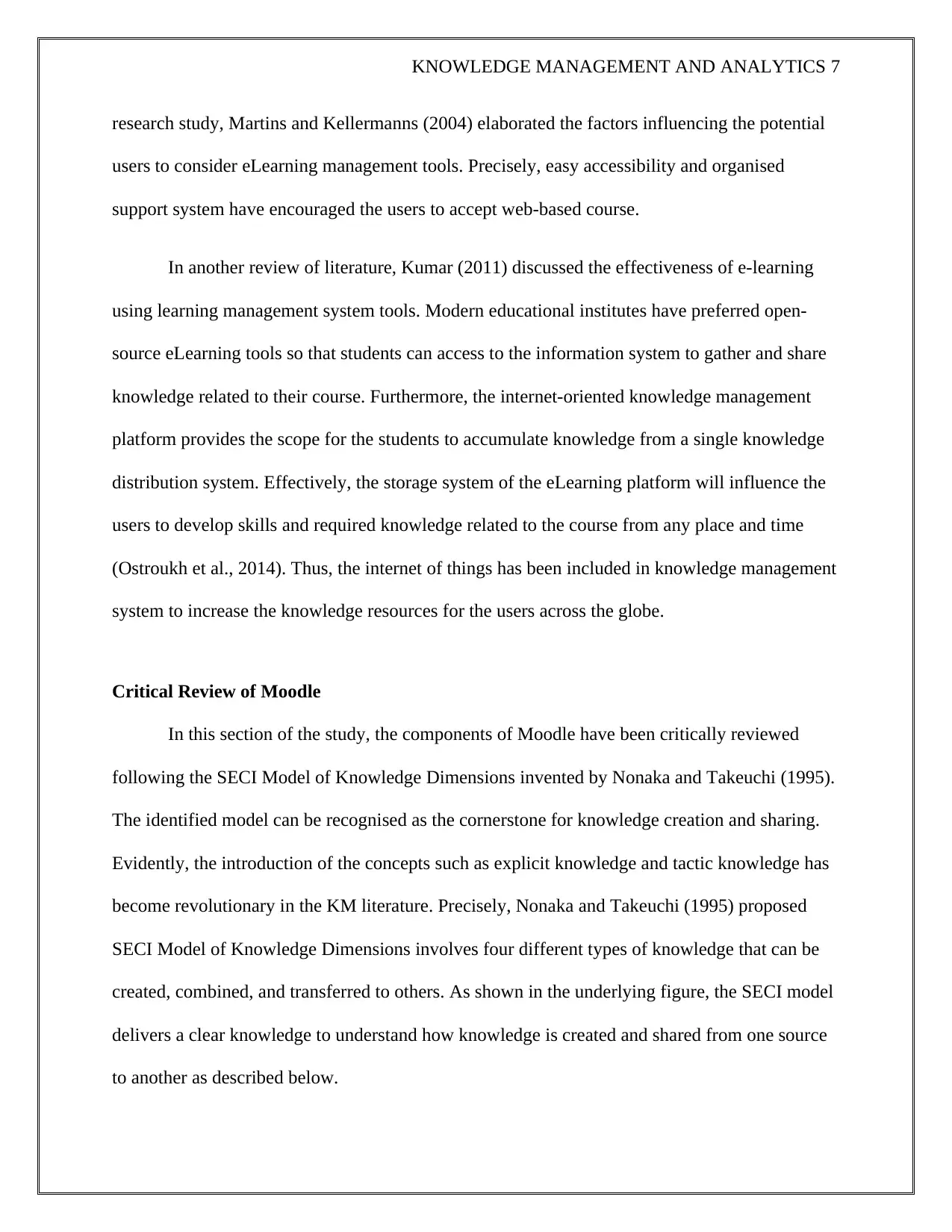
KNOWLEDGE MANAGEMENT AND ANALYTICS 7
research study, Martins and Kellermanns (2004) elaborated the factors influencing the potential
users to consider eLearning management tools. Precisely, easy accessibility and organised
support system have encouraged the users to accept web-based course.
In another review of literature, Kumar (2011) discussed the effectiveness of e-learning
using learning management system tools. Modern educational institutes have preferred open-
source eLearning tools so that students can access to the information system to gather and share
knowledge related to their course. Furthermore, the internet-oriented knowledge management
platform provides the scope for the students to accumulate knowledge from a single knowledge
distribution system. Effectively, the storage system of the eLearning platform will influence the
users to develop skills and required knowledge related to the course from any place and time
(Ostroukh et al., 2014). Thus, the internet of things has been included in knowledge management
system to increase the knowledge resources for the users across the globe.
Critical Review of Moodle
In this section of the study, the components of Moodle have been critically reviewed
following the SECI Model of Knowledge Dimensions invented by Nonaka and Takeuchi (1995).
The identified model can be recognised as the cornerstone for knowledge creation and sharing.
Evidently, the introduction of the concepts such as explicit knowledge and tactic knowledge has
become revolutionary in the KM literature. Precisely, Nonaka and Takeuchi (1995) proposed
SECI Model of Knowledge Dimensions involves four different types of knowledge that can be
created, combined, and transferred to others. As shown in the underlying figure, the SECI model
delivers a clear knowledge to understand how knowledge is created and shared from one source
to another as described below.
research study, Martins and Kellermanns (2004) elaborated the factors influencing the potential
users to consider eLearning management tools. Precisely, easy accessibility and organised
support system have encouraged the users to accept web-based course.
In another review of literature, Kumar (2011) discussed the effectiveness of e-learning
using learning management system tools. Modern educational institutes have preferred open-
source eLearning tools so that students can access to the information system to gather and share
knowledge related to their course. Furthermore, the internet-oriented knowledge management
platform provides the scope for the students to accumulate knowledge from a single knowledge
distribution system. Effectively, the storage system of the eLearning platform will influence the
users to develop skills and required knowledge related to the course from any place and time
(Ostroukh et al., 2014). Thus, the internet of things has been included in knowledge management
system to increase the knowledge resources for the users across the globe.
Critical Review of Moodle
In this section of the study, the components of Moodle have been critically reviewed
following the SECI Model of Knowledge Dimensions invented by Nonaka and Takeuchi (1995).
The identified model can be recognised as the cornerstone for knowledge creation and sharing.
Evidently, the introduction of the concepts such as explicit knowledge and tactic knowledge has
become revolutionary in the KM literature. Precisely, Nonaka and Takeuchi (1995) proposed
SECI Model of Knowledge Dimensions involves four different types of knowledge that can be
created, combined, and transferred to others. As shown in the underlying figure, the SECI model
delivers a clear knowledge to understand how knowledge is created and shared from one source
to another as described below.
Paraphrase This Document
Need a fresh take? Get an instant paraphrase of this document with our AI Paraphraser
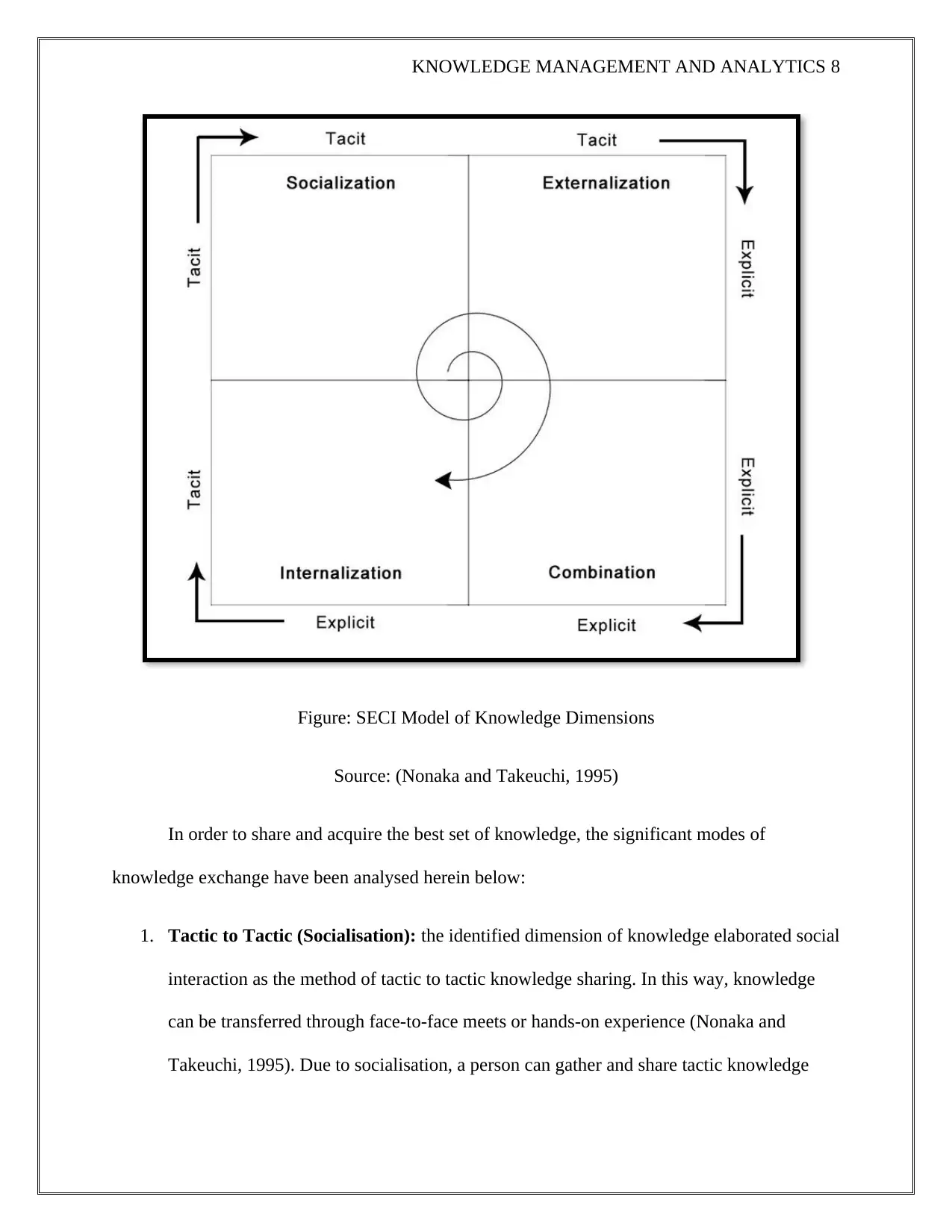
KNOWLEDGE MANAGEMENT AND ANALYTICS 8
Figure: SECI Model of Knowledge Dimensions
Source: (Nonaka and Takeuchi, 1995)
In order to share and acquire the best set of knowledge, the significant modes of
knowledge exchange have been analysed herein below:
1. Tactic to Tactic (Socialisation): the identified dimension of knowledge elaborated social
interaction as the method of tactic to tactic knowledge sharing. In this way, knowledge
can be transferred through face-to-face meets or hands-on experience (Nonaka and
Takeuchi, 1995). Due to socialisation, a person can gather and share tactic knowledge
Figure: SECI Model of Knowledge Dimensions
Source: (Nonaka and Takeuchi, 1995)
In order to share and acquire the best set of knowledge, the significant modes of
knowledge exchange have been analysed herein below:
1. Tactic to Tactic (Socialisation): the identified dimension of knowledge elaborated social
interaction as the method of tactic to tactic knowledge sharing. In this way, knowledge
can be transferred through face-to-face meets or hands-on experience (Nonaka and
Takeuchi, 1995). Due to socialisation, a person can gather and share tactic knowledge
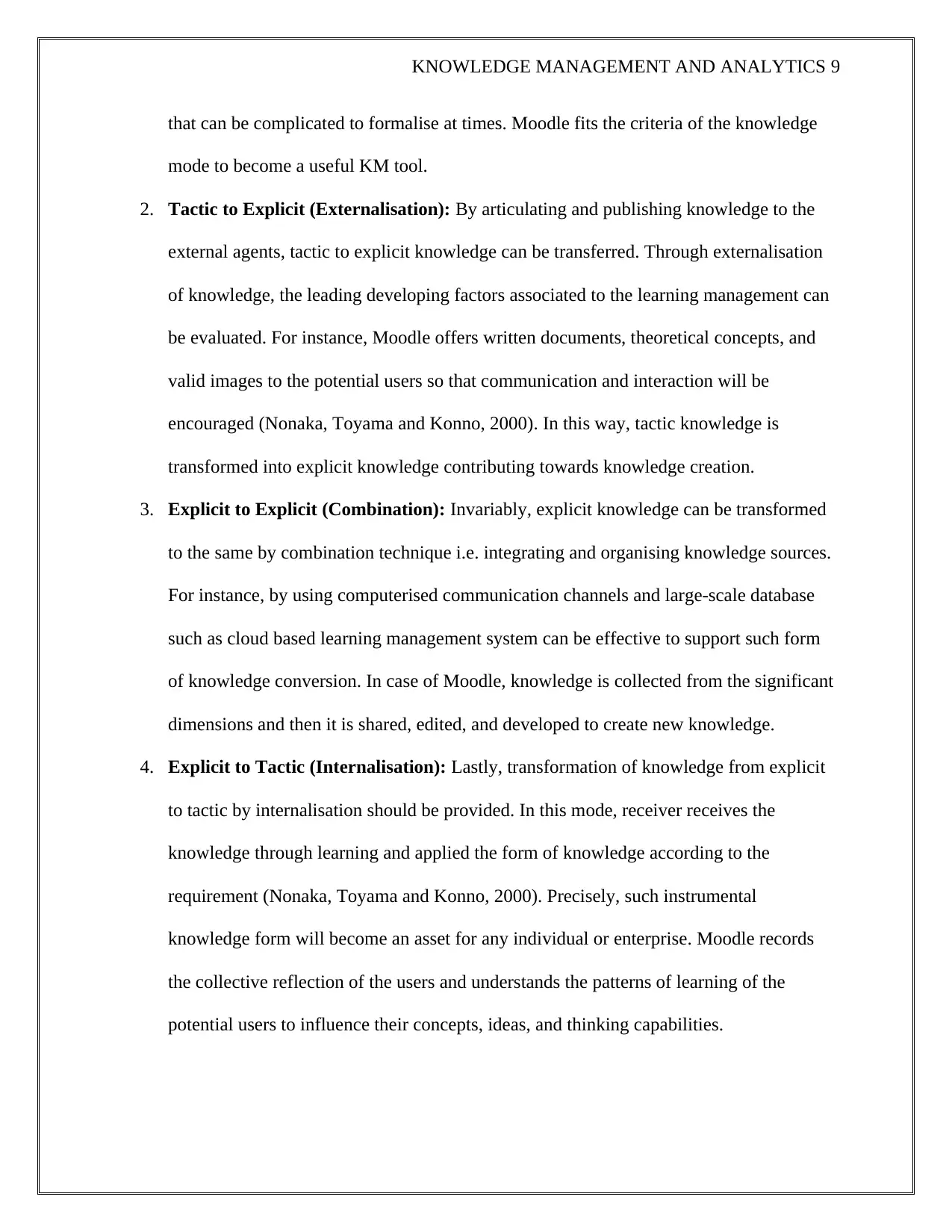
KNOWLEDGE MANAGEMENT AND ANALYTICS 9
that can be complicated to formalise at times. Moodle fits the criteria of the knowledge
mode to become a useful KM tool.
2. Tactic to Explicit (Externalisation): By articulating and publishing knowledge to the
external agents, tactic to explicit knowledge can be transferred. Through externalisation
of knowledge, the leading developing factors associated to the learning management can
be evaluated. For instance, Moodle offers written documents, theoretical concepts, and
valid images to the potential users so that communication and interaction will be
encouraged (Nonaka, Toyama and Konno, 2000). In this way, tactic knowledge is
transformed into explicit knowledge contributing towards knowledge creation.
3. Explicit to Explicit (Combination): Invariably, explicit knowledge can be transformed
to the same by combination technique i.e. integrating and organising knowledge sources.
For instance, by using computerised communication channels and large-scale database
such as cloud based learning management system can be effective to support such form
of knowledge conversion. In case of Moodle, knowledge is collected from the significant
dimensions and then it is shared, edited, and developed to create new knowledge.
4. Explicit to Tactic (Internalisation): Lastly, transformation of knowledge from explicit
to tactic by internalisation should be provided. In this mode, receiver receives the
knowledge through learning and applied the form of knowledge according to the
requirement (Nonaka, Toyama and Konno, 2000). Precisely, such instrumental
knowledge form will become an asset for any individual or enterprise. Moodle records
the collective reflection of the users and understands the patterns of learning of the
potential users to influence their concepts, ideas, and thinking capabilities.
that can be complicated to formalise at times. Moodle fits the criteria of the knowledge
mode to become a useful KM tool.
2. Tactic to Explicit (Externalisation): By articulating and publishing knowledge to the
external agents, tactic to explicit knowledge can be transferred. Through externalisation
of knowledge, the leading developing factors associated to the learning management can
be evaluated. For instance, Moodle offers written documents, theoretical concepts, and
valid images to the potential users so that communication and interaction will be
encouraged (Nonaka, Toyama and Konno, 2000). In this way, tactic knowledge is
transformed into explicit knowledge contributing towards knowledge creation.
3. Explicit to Explicit (Combination): Invariably, explicit knowledge can be transformed
to the same by combination technique i.e. integrating and organising knowledge sources.
For instance, by using computerised communication channels and large-scale database
such as cloud based learning management system can be effective to support such form
of knowledge conversion. In case of Moodle, knowledge is collected from the significant
dimensions and then it is shared, edited, and developed to create new knowledge.
4. Explicit to Tactic (Internalisation): Lastly, transformation of knowledge from explicit
to tactic by internalisation should be provided. In this mode, receiver receives the
knowledge through learning and applied the form of knowledge according to the
requirement (Nonaka, Toyama and Konno, 2000). Precisely, such instrumental
knowledge form will become an asset for any individual or enterprise. Moodle records
the collective reflection of the users and understands the patterns of learning of the
potential users to influence their concepts, ideas, and thinking capabilities.
⊘ This is a preview!⊘
Do you want full access?
Subscribe today to unlock all pages.

Trusted by 1+ million students worldwide
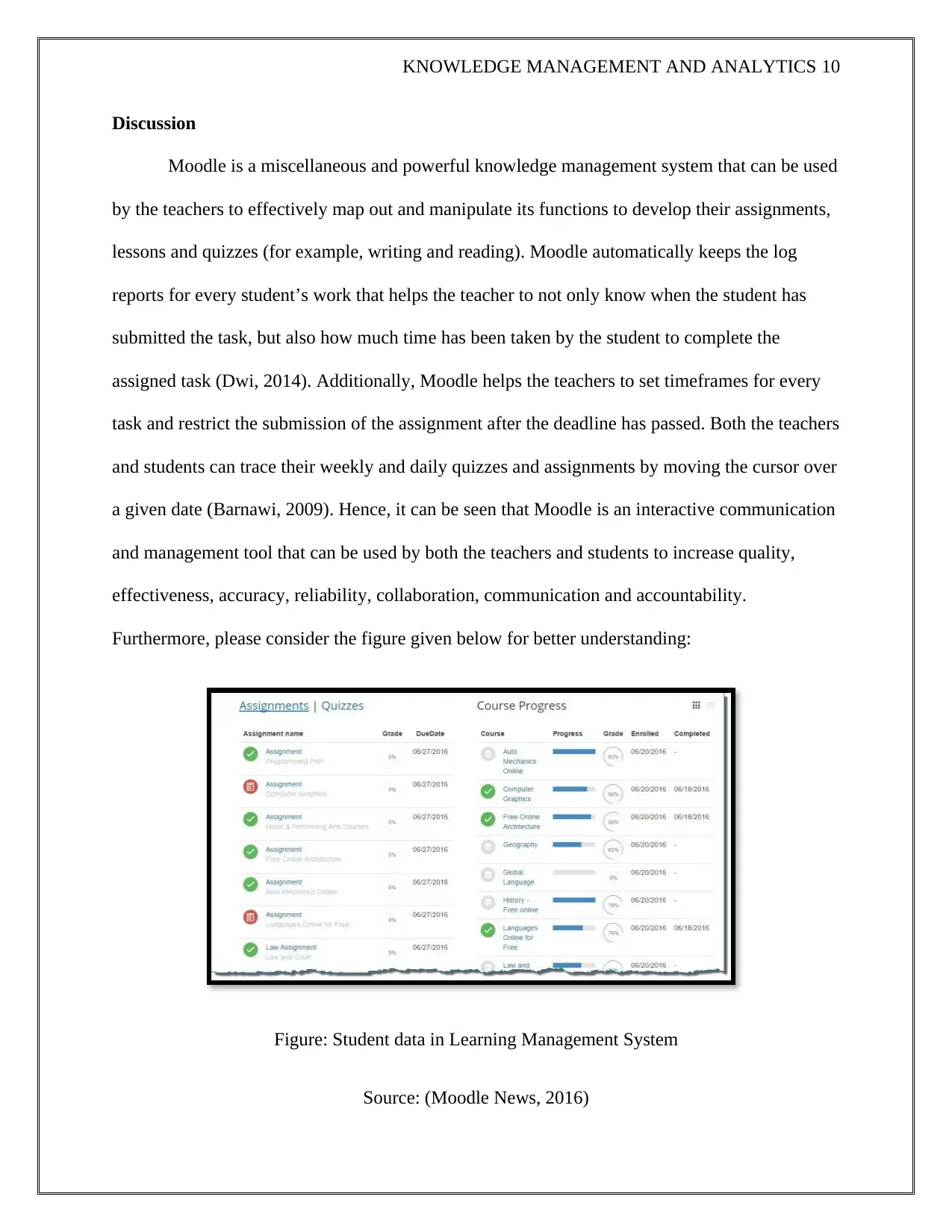
KNOWLEDGE MANAGEMENT AND ANALYTICS 10
Discussion
Moodle is a miscellaneous and powerful knowledge management system that can be used
by the teachers to effectively map out and manipulate its functions to develop their assignments,
lessons and quizzes (for example, writing and reading). Moodle automatically keeps the log
reports for every student’s work that helps the teacher to not only know when the student has
submitted the task, but also how much time has been taken by the student to complete the
assigned task (Dwi, 2014). Additionally, Moodle helps the teachers to set timeframes for every
task and restrict the submission of the assignment after the deadline has passed. Both the teachers
and students can trace their weekly and daily quizzes and assignments by moving the cursor over
a given date (Barnawi, 2009). Hence, it can be seen that Moodle is an interactive communication
and management tool that can be used by both the teachers and students to increase quality,
effectiveness, accuracy, reliability, collaboration, communication and accountability.
Furthermore, please consider the figure given below for better understanding:
Figure: Student data in Learning Management System
Source: (Moodle News, 2016)
Discussion
Moodle is a miscellaneous and powerful knowledge management system that can be used
by the teachers to effectively map out and manipulate its functions to develop their assignments,
lessons and quizzes (for example, writing and reading). Moodle automatically keeps the log
reports for every student’s work that helps the teacher to not only know when the student has
submitted the task, but also how much time has been taken by the student to complete the
assigned task (Dwi, 2014). Additionally, Moodle helps the teachers to set timeframes for every
task and restrict the submission of the assignment after the deadline has passed. Both the teachers
and students can trace their weekly and daily quizzes and assignments by moving the cursor over
a given date (Barnawi, 2009). Hence, it can be seen that Moodle is an interactive communication
and management tool that can be used by both the teachers and students to increase quality,
effectiveness, accuracy, reliability, collaboration, communication and accountability.
Furthermore, please consider the figure given below for better understanding:
Figure: Student data in Learning Management System
Source: (Moodle News, 2016)
Paraphrase This Document
Need a fresh take? Get an instant paraphrase of this document with our AI Paraphraser
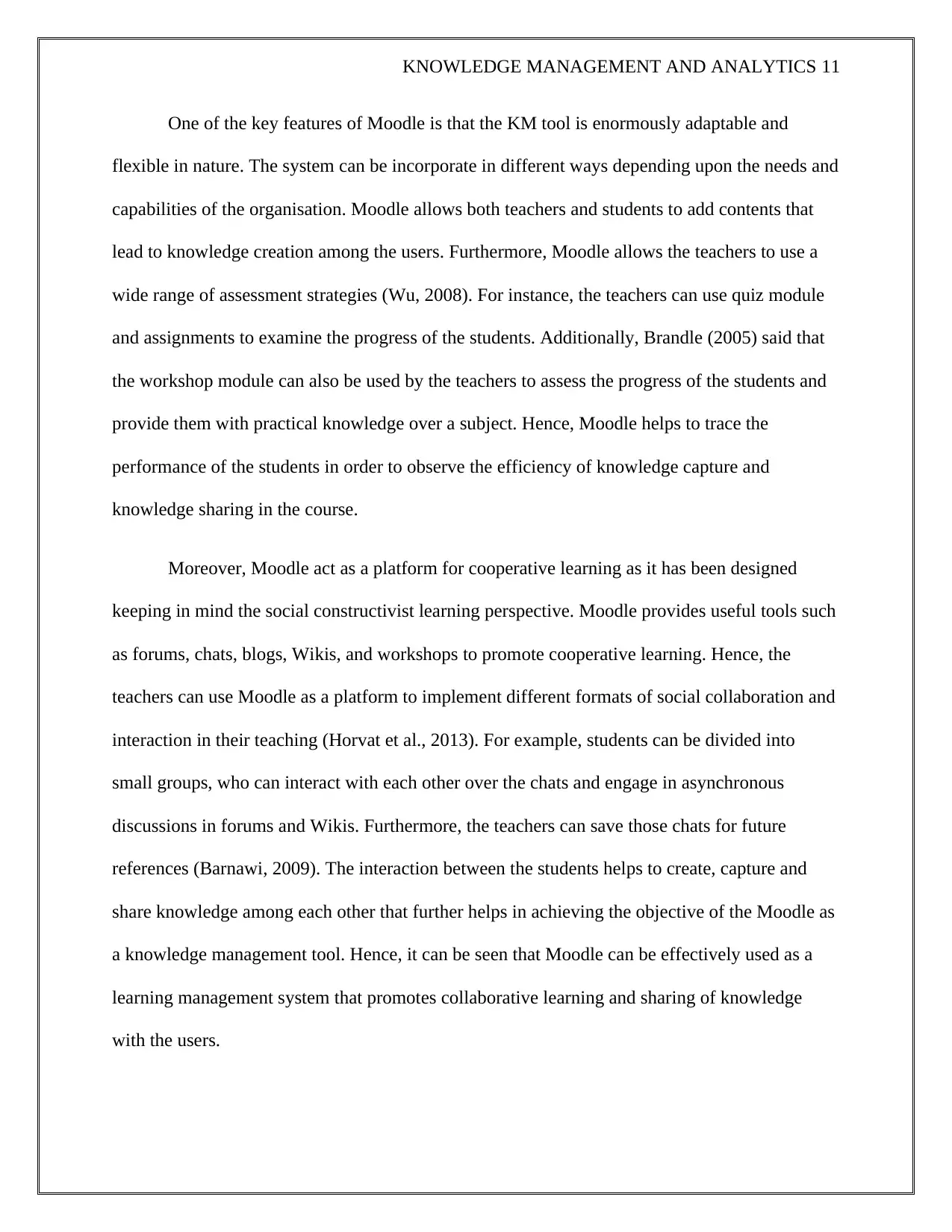
KNOWLEDGE MANAGEMENT AND ANALYTICS 11
One of the key features of Moodle is that the KM tool is enormously adaptable and
flexible in nature. The system can be incorporate in different ways depending upon the needs and
capabilities of the organisation. Moodle allows both teachers and students to add contents that
lead to knowledge creation among the users. Furthermore, Moodle allows the teachers to use a
wide range of assessment strategies (Wu, 2008). For instance, the teachers can use quiz module
and assignments to examine the progress of the students. Additionally, Brandle (2005) said that
the workshop module can also be used by the teachers to assess the progress of the students and
provide them with practical knowledge over a subject. Hence, Moodle helps to trace the
performance of the students in order to observe the efficiency of knowledge capture and
knowledge sharing in the course.
Moreover, Moodle act as a platform for cooperative learning as it has been designed
keeping in mind the social constructivist learning perspective. Moodle provides useful tools such
as forums, chats, blogs, Wikis, and workshops to promote cooperative learning. Hence, the
teachers can use Moodle as a platform to implement different formats of social collaboration and
interaction in their teaching (Horvat et al., 2013). For example, students can be divided into
small groups, who can interact with each other over the chats and engage in asynchronous
discussions in forums and Wikis. Furthermore, the teachers can save those chats for future
references (Barnawi, 2009). The interaction between the students helps to create, capture and
share knowledge among each other that further helps in achieving the objective of the Moodle as
a knowledge management tool. Hence, it can be seen that Moodle can be effectively used as a
learning management system that promotes collaborative learning and sharing of knowledge
with the users.
One of the key features of Moodle is that the KM tool is enormously adaptable and
flexible in nature. The system can be incorporate in different ways depending upon the needs and
capabilities of the organisation. Moodle allows both teachers and students to add contents that
lead to knowledge creation among the users. Furthermore, Moodle allows the teachers to use a
wide range of assessment strategies (Wu, 2008). For instance, the teachers can use quiz module
and assignments to examine the progress of the students. Additionally, Brandle (2005) said that
the workshop module can also be used by the teachers to assess the progress of the students and
provide them with practical knowledge over a subject. Hence, Moodle helps to trace the
performance of the students in order to observe the efficiency of knowledge capture and
knowledge sharing in the course.
Moreover, Moodle act as a platform for cooperative learning as it has been designed
keeping in mind the social constructivist learning perspective. Moodle provides useful tools such
as forums, chats, blogs, Wikis, and workshops to promote cooperative learning. Hence, the
teachers can use Moodle as a platform to implement different formats of social collaboration and
interaction in their teaching (Horvat et al., 2013). For example, students can be divided into
small groups, who can interact with each other over the chats and engage in asynchronous
discussions in forums and Wikis. Furthermore, the teachers can save those chats for future
references (Barnawi, 2009). The interaction between the students helps to create, capture and
share knowledge among each other that further helps in achieving the objective of the Moodle as
a knowledge management tool. Hence, it can be seen that Moodle can be effectively used as a
learning management system that promotes collaborative learning and sharing of knowledge
with the users.
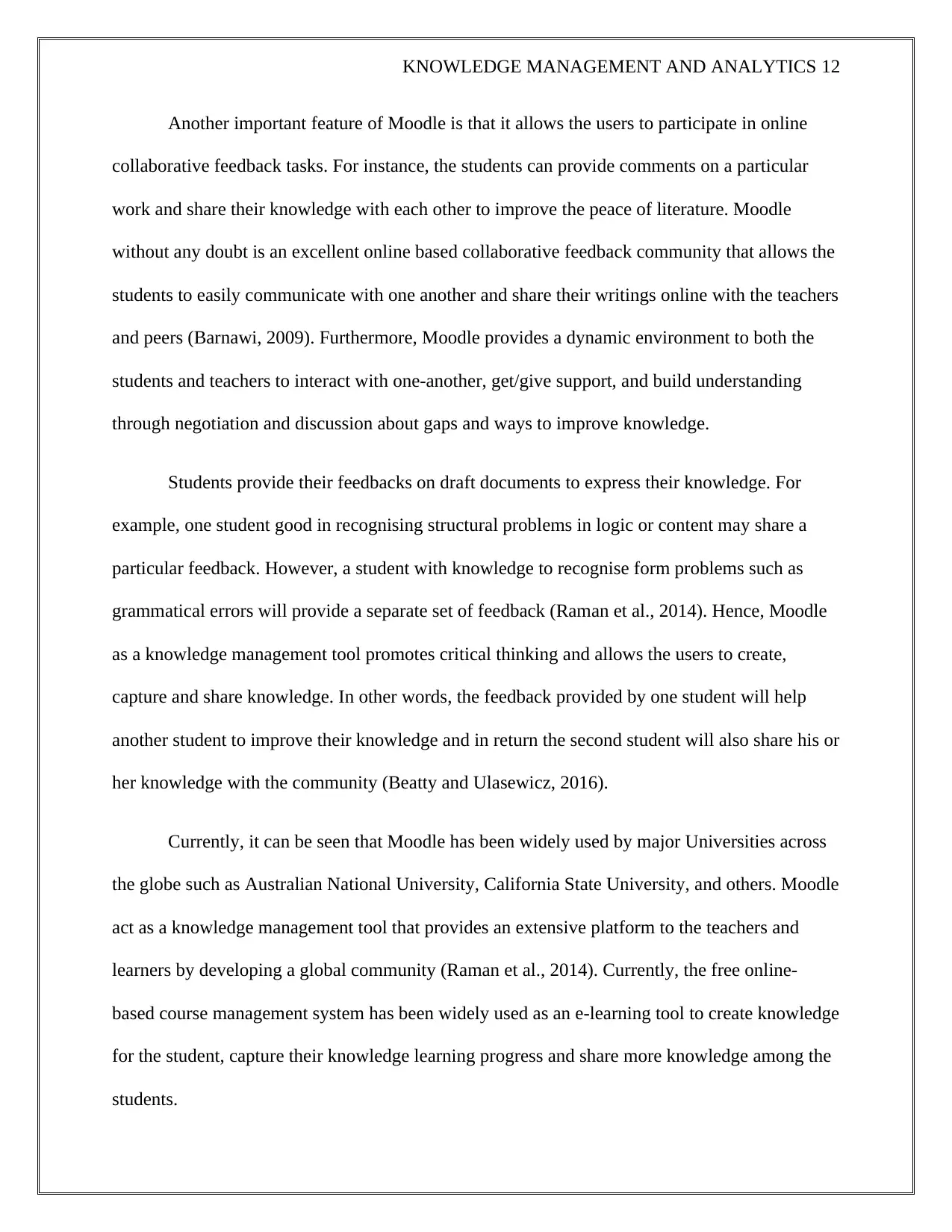
KNOWLEDGE MANAGEMENT AND ANALYTICS 12
Another important feature of Moodle is that it allows the users to participate in online
collaborative feedback tasks. For instance, the students can provide comments on a particular
work and share their knowledge with each other to improve the peace of literature. Moodle
without any doubt is an excellent online based collaborative feedback community that allows the
students to easily communicate with one another and share their writings online with the teachers
and peers (Barnawi, 2009). Furthermore, Moodle provides a dynamic environment to both the
students and teachers to interact with one-another, get/give support, and build understanding
through negotiation and discussion about gaps and ways to improve knowledge.
Students provide their feedbacks on draft documents to express their knowledge. For
example, one student good in recognising structural problems in logic or content may share a
particular feedback. However, a student with knowledge to recognise form problems such as
grammatical errors will provide a separate set of feedback (Raman et al., 2014). Hence, Moodle
as a knowledge management tool promotes critical thinking and allows the users to create,
capture and share knowledge. In other words, the feedback provided by one student will help
another student to improve their knowledge and in return the second student will also share his or
her knowledge with the community (Beatty and Ulasewicz, 2016).
Currently, it can be seen that Moodle has been widely used by major Universities across
the globe such as Australian National University, California State University, and others. Moodle
act as a knowledge management tool that provides an extensive platform to the teachers and
learners by developing a global community (Raman et al., 2014). Currently, the free online-
based course management system has been widely used as an e-learning tool to create knowledge
for the student, capture their knowledge learning progress and share more knowledge among the
students.
Another important feature of Moodle is that it allows the users to participate in online
collaborative feedback tasks. For instance, the students can provide comments on a particular
work and share their knowledge with each other to improve the peace of literature. Moodle
without any doubt is an excellent online based collaborative feedback community that allows the
students to easily communicate with one another and share their writings online with the teachers
and peers (Barnawi, 2009). Furthermore, Moodle provides a dynamic environment to both the
students and teachers to interact with one-another, get/give support, and build understanding
through negotiation and discussion about gaps and ways to improve knowledge.
Students provide their feedbacks on draft documents to express their knowledge. For
example, one student good in recognising structural problems in logic or content may share a
particular feedback. However, a student with knowledge to recognise form problems such as
grammatical errors will provide a separate set of feedback (Raman et al., 2014). Hence, Moodle
as a knowledge management tool promotes critical thinking and allows the users to create,
capture and share knowledge. In other words, the feedback provided by one student will help
another student to improve their knowledge and in return the second student will also share his or
her knowledge with the community (Beatty and Ulasewicz, 2016).
Currently, it can be seen that Moodle has been widely used by major Universities across
the globe such as Australian National University, California State University, and others. Moodle
act as a knowledge management tool that provides an extensive platform to the teachers and
learners by developing a global community (Raman et al., 2014). Currently, the free online-
based course management system has been widely used as an e-learning tool to create knowledge
for the student, capture their knowledge learning progress and share more knowledge among the
students.
⊘ This is a preview!⊘
Do you want full access?
Subscribe today to unlock all pages.

Trusted by 1+ million students worldwide
1 out of 18
Related Documents
Your All-in-One AI-Powered Toolkit for Academic Success.
+13062052269
info@desklib.com
Available 24*7 on WhatsApp / Email
![[object Object]](/_next/static/media/star-bottom.7253800d.svg)
Unlock your academic potential
Copyright © 2020–2025 A2Z Services. All Rights Reserved. Developed and managed by ZUCOL.


